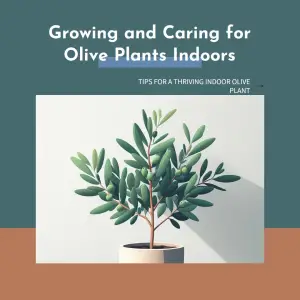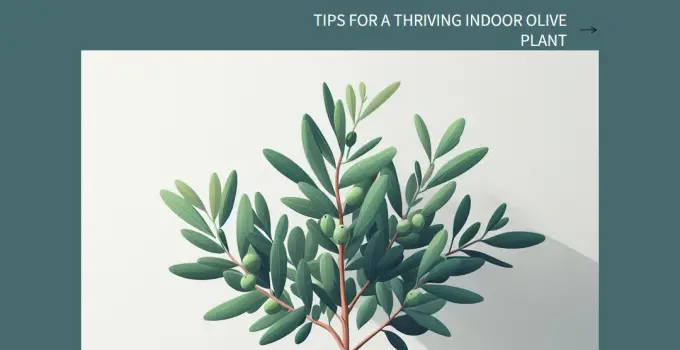50 PCS Small American Flags on Stick, 4 x 6 Inches 4th of July Decorations, Tear Resistant Patriotic USA Flag Fourth of July Flags, Anti Wrinkle Handheld Memorial Day Decor for Parade
$11.99 (as of July 9, 2025 21:54 GMT +00:00 - More infoProduct prices and availability are accurate as of the date/time indicated and are subject to change. Any price and availability information displayed on [relevant Amazon Site(s), as applicable] at the time of purchase will apply to the purchase of this product.)Intex 26701EH Prism Frame Premium Above Ground Swimming Pool Set: 10ft x 30in – Includes 330 GPH Cartridge Filter Pump – SuperTough Puncture Resistant – Rust Resistant – 1185 Gallon Capacity
33% OffHow to Grow and Care for Olive Plants Indoors
Olive trees are one of the most iconic plants in the Mediterranean region. With their gnarly trunks and delicate, silver-green foliage, it’s no wonder many gardeners want to bring some of that Mediterranean charm indoors.
While primarily grown commercially for olive production, ornamental olive trees make excellent indoor houseplants. With the right care and conditions, you can grow a potted olive tree that thrives indoors and becomes a beautiful centerpiece plant.
In this complete indoor olive plant care guide, you’ll learn:
- Olive tree background and benefits
- Choosing the right olive cultivar
- Potting and planting your olive
- Optimal light conditions
- Watering and soil needs
- Humidity, temperature, and fertilization
- Pruning and training an indoor olive tree
- Propagation and troubleshooting
Let’s get started growing these iconic Mediterranean trees indoors!
Olive Tree Background
The olive tree (Olea europaea) traces its origins to the Mediterranean basin, where it has been cultivated for thousands of years. In ancient times, the olive branch was revered as a symbol of peace and victory.
Today, olive trees are widely grown across the Mediterranean for their edible fruit and oil production. There are over 2,000 different olive cultivars, ranging from small shrubs to large trees up to 30 feet tall.
In addition to their production value, olive trees are highly valued ornamentally for their graceful, spiral-shaped foliage and highly textured trunks. Plus, they are long-lived trees that can thrive for hundreds of years.
When grown indoors, olive trees make excellent houseplants. They grow slowly and remain at a manageable size. Their handsome forms and silver-colored leaves add uniqueness to indoor plant collections.
Benefits of Keeping an Olive Tree Indoors

Beyond their elegant visual appeal, olive trees provide some great benefits when kept as houseplants:
- Clean air: Olive leaves absorb carbon dioxide and release oxygen through the night, helping purify indoor air.
- Reduce stress: Caring for houseplants like an olive tree can lower stress and anxiety.
- Easy maintenance: Olives are relatively hands-off once established, only needing occasional watering and pruning.
- Fragrance: Olive blooms have a delicate, honey-like aroma you can enjoy indoors.
- Fruit: With enough light and age, potted olives can bear edible fruits.
- Long-lived: Olive trees are very long-lived and can stay in the same pot for years.
For these reasons and more, olive trees make excellent long-term indoor plant companions. Next, let’s look at choosing a suitable cultivar.
Choosing an Olive Cultivar for Indoors
When selecting an olive cultivar for indoor growing, look for types known to thrive in containers and remain a smaller, manageable size. Some top choices include:
- ‘Arbequina’ – A highly popular Spanish cultivar bearing loads of small fruit. Stays under 10 feet tall in a pot.
- ‘Maurino’ – A dwarf cultivar that only reaches 6 feet tall. Slow-growing and easy to maintain.
- ‘Pendolino’ – A dwarf, cold-hardy type good for pot culture. Grows up to 8 feet.
- ‘Frantoio’ – A classic Italian olive that does well potted. Grows up to 10-15 feet.
- ‘Sevillano’ – A Spanish selection bearing large crops of olives in a shrub-like form.
Look for young olive trees in 1-3 gallon pots, around 2-4 feet tall. Larger containers restrict growth less, so pick the biggest pot size you can accommodate. With the right pruning, even full-size olive trees can be maintained in containers.
Key Care Needs for Indoor Olive Trees

| Factor | Recommendations |
|---|---|
| Light | 6+ hours of direct sun daily from the south or west window. Supplement with grow lights if needed. |
| Water | Allow soil to dry out partially between waterings. Target every 1-2 weeks on average. |
| Temperature | 60-75°F during the day, 45-55°F at night. Can tolerate short periods down to 35°F or up to 85°F. |
| Humidity | 40-60% ambient humidity. Increase through misting, pebble trays, or grouping with other plants. |
| Soil | Fast-draining potting mix amended with compost or worm castings. |
| Fertilizer | Balanced liquid fertilizer monthly in spring and summer. Discontinue in winter. |
| Pruning | Prune annually to contain size and shape. Remove at least 1/3 of the prior year’s growth. |
Now let’s look at potting and planting your new olive tree.
Potting and Planting Your Olive Tree
When you bring home your young olive tree, follow these tips for getting it potted properly:
- Choose a large container: Select a pot at least 18-24 inches wide and deep for the first few years. Bigger is better to allow root growth.
- Use potting soil: Use a quality potting mix, not garden soil. Olive trees need good drainage.
- Plant at original depth: Plant at the same soil depth as the nursery container. Don’t plant too deeply.
- Water thoroughly: Water thoroughly until drainage flows from the base after planting.
- Add mulch: Top off with an inch layer of fine bark mulch to retain moisture.
Olive trees have deep taproots, so container depth is important to allow adequate rooting room. Water regularly after planting to encourage establishment. Now let’s look at their optimal light needs.
Light Requirements
Olive trees thrive best in full sun outdoors. When grown as houseplants, they need as much bright light as possible to emulate their native Mediterranean environment.
Here are some indoor olive tree light tips:
- Place near a south or west-facing window if possible. East can work too.
- Provide at least 6 hours of direct sun daily, or supplement with grow lights.
- Rotate the pot weekly for even sun exposure.
- Prune actively to allow light penetration to inner branches.
- Move outdoors seasonally if the climate allows.
Without enough sun, olive leaves will turn solid green and growth will slow. Insufficient light also discourages flowering and fruit production. Give your olive tree the brightest, sunniest spot indoors!
Watering Your Olive Tree
Establishing a good watering routine is key to keeping an olive tree happy indoors. Here are tips on olive water needs:
- Allow soil to dry out partially between waterings. Do not overwater.
- Water when the top few inches become dry. Target every 1-2 weeks.
- Drooping leaves or soil pulling from edges means under-watering.
- Yellow leaves and softwood are signs of overwatering.
- Container size and heat exposure affect watering frequency. Adjust as needed.
- Olives prefer consistent moisture. Avoid dramatic dry-to-soaked cycles.
- Water until drainage flows from the base to flush salts from the soil.
- Feel the soil to gauge moisture instead of strict schedules.
Olive trees are drought tolerant, so occasional mild dryness is okay. But insufficient water will quickly distress them. Monitor soil moisture and leaf appearance closely to perfect your watering routine.
Olive Tree Soil Needs
Like other Mediterranean natives, olive trees need a fast-draining yet nutrient-rich soil. Here are some tips for potting mix:
- Use a general potting soil with added perlite for drainage.
- Mix in compost or worm castings to provide nutrients.
- Test and amend soil pH to 6.5-7 range if needed.
- Re-pot every 2-3 years using fresh potting mix.
- Add mycorrhizal inoculant to help root health.
- Top dress annually with worm castings or compost.
Quality potting soil provides an ideal foundation. Adding organic matter through compost improves fertility over time while maintaining a loose texture.
Humidity, Temperature, and Fertilizer
Providing suitable humidity, temperatures, and nutrition keeps your indoor olive thriving. Here are tips for each:
Humidity
- Olive trees prefer 40-60% ambient humidity if possible.
- Increase humidity by misting leaves, using a pebble tray, or grouping with other plants.
- Ensure good air circulation to prevent disease issues in humid conditions.
Temperature
- The ideal range is 60-75°F during the day and 45-55°F at night.
- Can tolerate short periods down to 35°F or up to 85°F. Avoid drastic shifts.
- Move to a cool spot in summer to avoid excess heat.
Fertilizer
- Fertilize monthly during spring and summer with a balanced all-purpose fertilizer.
- Discontinue feeding over winter when growth slows.
- Supplement with annual top dressing of compost or worm castings.
- Watch for signs of nutrient excess like burnt leaf tips.
Meeting these basic needs provides a healthy foundation for indoor olive trees. Next, let’s look at effective pruning and training.
Pruning and Training Indoor Olive Trees
Pruning is critical for keeping an olive tree both small and productive in a pot. Here are some pruning tips:
- When to prune – Prune in late winter just before spring growth emerges. Remove crossing, damaged, or inward-facing branches.
- Keep it small – Prune to contain size and shape. Reduce growth by at least one-third annually.
- Increase light – Remove inner branches that block light penetration. Keep the canopy open.
- Encourage branches – Prune judiciously to promote outward branching and form.
- Move outside – Place the tree outdoors and remove all olives to redirect energy after heavy pruning.
- Prune annually – Frequent light pruning is better than infrequent drastic pruning.
With training, indoor olives can be shaped into single-trunk specimens, bushy shrubs, espalier against walls, or other forms. Be creative and have fun!
Propagating and Repotting Olive Trees
Olive trees can be easily propagated indoors by taking stem cuttings in summer:
- Take 6-8 inch cuttings from young lateral shoots. Remove lower leaves.
- Dip end in rooting hormone and plant in potting mix. Provide warmth and humidity.
- Rooting takes 4-6 weeks. Transplant to larger pots after adequate root growth.
When potted olive trees outgrow their containers, increase pot size or prune roots and report:
- Repot in early spring before growth resumes.
- Remove 1/3 of the roots and soil ball using pruning shears.
- Replant in fresh potting mix in a slightly larger container.
With regular pruning, repotting may only be needed every 4-5 years. Propagating and repotting lets you expand your olive collection!
Troubleshooting Common Olive Tree Issues
Olive trees are relatively pest and disease-resistant. But here are solutions to a few potential issues:
- Leaf drop – Ensure adequate water and humidity. Drop is common after transplant shock.
- Weak growth – Increase light exposure and fertilize monthly during the growing season.
- Dry leaf tips – Usually from insufficient humidity. Increase humidity around the plant.
- Slugs – Remove by handpicking. Reduce hiding spots by pruning. Diatomaceous earth also helps control slugs.
- Fungus gnats – Let the soil dry out completely between waterings. Use yellow sticky traps. Introduce predatory nematodes.
With proper care, indoor olive trees are generally vigorous and trouble-free. Diagnose and address any issues promptly to keep your tree healthy.
Enjoying Your Indoor Olive Tree
Olive trees are iconic plants that bring graceful form, silver-green foliage, and Mediterranean character to indoor environments. With bright light, occasional pruning, and proper watering, an olive tree thrives as a unique living sculpture indoors.
Place your olive in a prominent spot where you can enjoy watching it grow and change through the seasons. As it matures, you may even harvest edible olives. Each time you care for and appreciate your olive tree, you’ll reap both physical and mental health benefits.
We hope this guide provides everything you need to successfully grow olive trees as breathtaking indoor plants. The stunning olive will bring you joy for years to come. Soon you’ll have your own flourishing miniature olive grove inside your home!




























